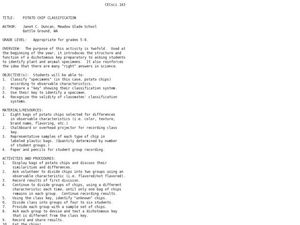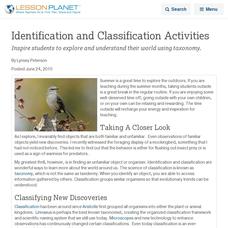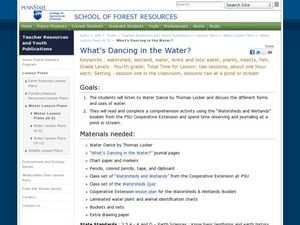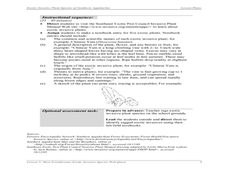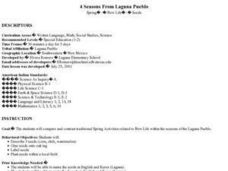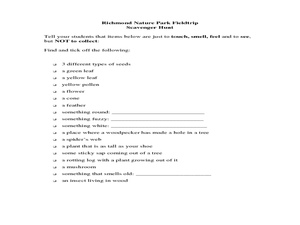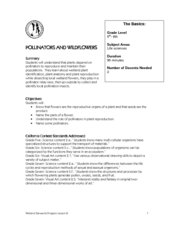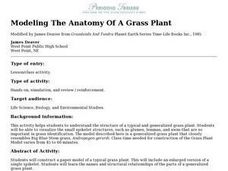Curated OER
Plants and Animals
Students find common needs between plants and animals. In this plants and animals lesson students compare that both plants and animals need food and water. They also find the differences between plant and animal needs.
Curated OER
Dry-Land Kalo-Growing New Plants from Stems
Students explore Hawaiian plants. In this Hawaii culture and botany lesson, students plant the haha(stem) of a taro plant. Students listen to Hawaiian myths about the taro plant and chorally speak a Hawaiian chant of protection. Students...
Curated OER
Potato chip Classification
Learners create a dichotomous key using potato chips. In this classification lesson, students sort potato chips into groups based on observable characteristics. They record their results to create a dichotomous key in preparation for...
Curated OER
Dinosaurs 1: Where Are the Dinosaurs?
Young scholars explore dinosaurs. In this dinosaur identification instructional activity, students watch video clips for different dinosaurs from the Discovery Kids website. Young scholars discuss the clips with their teacher. Students...
Curated OER
Identifying plants, animals, insects, reptiles, and birds on the prairie
Young scholars identify all of the plant an animal life on the prairie. In this plant identification lesson students divide into groups and draw sketches of things they saw on the prairie.
Curated OER
Identification and Classification Activities
Explore and understand your world with taxonomy.
Curated OER
What's Dancing in the Water?
Students learn about watershed, as well as the different forms and uses of water. In this water forms activity, students brainstorm water sources and uses. Students read the book Water Dance and discuss water examples. Students complete...
Curated OER
The Great Migration
Sixth graders explore the uses of herbal plants. They read the book Pharmacy in the Forest and discuss the vocabulary words that pertain to the structure of a plant. Students create a summary of what they have read and watch a video on...
Curated OER
Animal Signs
Students discuss the many different types of animal signs that can be used to identify and track animals. They participate in an hands-on activity in which they examine tracks, trails, homes, territory markings, and even "scat" left by...
Curated OER
Prairie Find Outdoors
Students take a field trip to a local prairie. Using identification books, they identify various forbs and grasses in the prairie. As a class, they discuss the importance of forbs and grasses to the ecosystem and review the various types...
Curated OER
In the Wild
Third graders examine the concept of ecology and how animals are suited to their habitats. For this animal adaptation lesson, 3rd graders identify a variety of plants and animal species that live in a Beech forest.Students create a food...
Curated OER
Loco for Cocoa
Sixth graders explore agriculture by viewing food related videos in class. In this chocolate identification lesson, 6th graders discuss the healthy aspects of pure cocoa and the history of the plant. Students read assigned text about...
Curated OER
Species and Specimens: Exploring Local Biodiversity
Students practice skills essential to all scientific investigation: carefully observing and collecting data. They become field biologists in a series of hands-on activities to collect and identify specimens, and survey and calculate the...
Curated OER
Leaves: All-Natural Solar Collectors
Take a good look at tree leaves and notice the adaptations for collecting solar energy. Pupils trace the margins of five different leaves onto graph paper and count the number of squares covered. They then relate this infomation to the...
Curated OER
Most Troublesome Exotic Invasive Plant Species Web Quest
Young scholars participate in a Web Quest activity in which they identify common exotic invasive plant species of the Southern Appalachian Region. After identifying the top 10 exotic invasive species, they choose one to research in depth.
Curated OER
Four Seasons From Laguna Pueblo
Students study seeds and spring planting. They plant corn, chili, watermelon seeds in a local field and then invite a farmer to come to discuss the preparation, caring and planting of seeds in a field.
Curated OER
How a Seed Grows and Who Grows It
First graders explore biology by viewing PowerPoint presentations in class. In this plant life lesson, 1st graders identify the life cycle of a plant and how to properly plant a seed outside. Students view a movie about plant life and...
Curated OER
Richmond Nature Park Field Trip
Pupils identify different plants and their uses by attending a field trip. In this Canadian plant lesson, students explore the great outdoors of Vancouver, B.C. and discuss the uses of plants by the Native Americans that once resided...
Curated OER
Do You Have the Key?
Students practice using a dichotomous key. In this classification lesson, students read an article about scientific exploration and identification of new species. They use a dichotomous key to identify objects and create their own key.
Curated OER
Pollinators and Wildflowers
Young scholars explore how plants depend on pollinators to reproduce. In this pollination lesson students dissect a local flower and collect and identify pollinating insects.
Curated OER
Nature and Fitness Trail
Young scholars plan stations for a nature and fitness trail and construct an accompanying e-Book for extended descriptions at each station. Data on the human impact on the environment is gathered in this lesson.
Curated OER
Modeling The Anatomy Of A Grass Plant
High schoolers explore the structure of a typical and generalized grass plant. They visualize the structures of a grass plant by constructing a paper model. In addition, they identify the names and structural relationships of the parts...
Curated OER
Logs of Straw: Dendocronology
Students investigate the age of trees by analyzing tree rings. In this dendocronology lesson, students examine sample images of tree rings and identify their age by the amount of rings. Students complete a chart identifying...
Curated OER
Teaching Kids about the Environment
Fifth graders identify the species of plants and animals found in an environment. They compare these findings to plant and animal species found in an unlike environment. Students acquire and compare soil samples from the two sites chosen.


